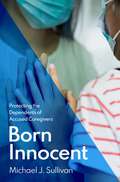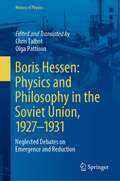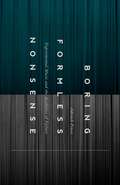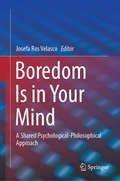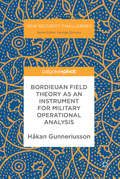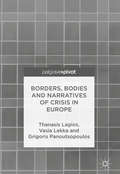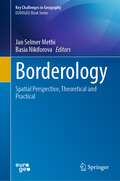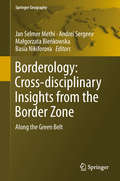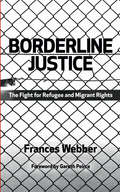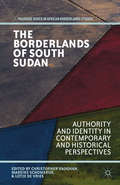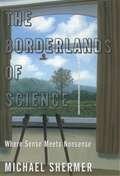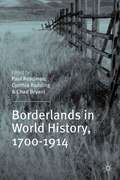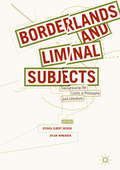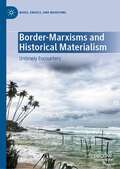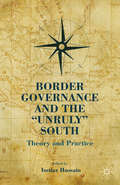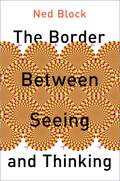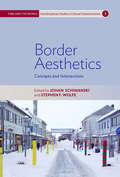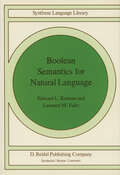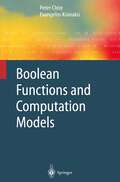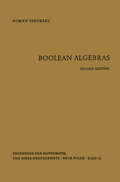- Table View
- List View
Born Innocent: Protecting the Dependents of Accused Caregivers
by Michael J. SullivanOver seven percent of all children in the United States--more than 5 million children--have experienced a parental incarceration, and an estimated 2.7 million children currently have a parent who is incarcerated. An additional 5 million children under age 18 live with at least one parent who is unauthorized to be in the United States and faces deportation. Children and other dependents suffer the collateral consequences of "preventive justice" measures increasingly used by liberal democratic countries to combat a broad range of suspected crime and anti-state activities. But what does the state owe to the innocent dependents of accused caregivers? In Born Innocent, Michael J. Sullivan explores the impact of vicarious punishment on children, with a particular focus on children in socioeconomically disadvantaged and racialized communities that are disproportionately subject to family separation based on their identity, allegiances, and immigration status. Sullivan advocates a turn from retribution to rehabilitation for convicted offenders, with a view towards helping them to become more effective caregivers who can continue to support their dependents during their sentence. Born Innocent goes beyond the children's rights literature on the collateral consequences of punishment to consider how "punishment drift" creates problems for both retributive and utilitarian theories of punishment. He draws on care ethics theory to widen our understanding of the range of collateral victims of punishment as well as possible rehabilitative and restorative measures. Sullivan also considers the limits of this approach, especially where it pertains to offenders who victimize their families, and those who resist rehabilitation and persist in anti-state actions that harm others. Original and compelling, Born Innocent provides one of the first unified treatments of state-sponsored family separation and its impact on disadvantaged citizens and immigrants.
Boris Hessen: Neglected Debates on Emergence and Reduction (History of Physics)
by Chris Talbot Olga PattisonThis book presents key works of Boris Hessen, outstanding Soviet philosopher of science, available here in English for the first time. Quality translations are accompanied by an editors' introduction and annotations. Boris Hessen is known in history of science circles for his “Social and Economic Roots of Newton’s Principia” presented in London (1931), which inspired new approaches in the West. As a philosopher and a physicist, he was tasked with developing a Marxist approach to science in the 1920s. He studied the history of physics to clarify issues such as reductionism and causality as they applied to new developments. With the philosophers called the “Dialecticians”, his debates with the opposing “Mechanists” on the issue of emergence are still worth studying and largely ignored in the many recent works on this subject. Taken as a whole, the book is a goldmine of insights into both the foundations of physics and Soviet history.
Boring Formless Nonsense: Experimental Music and the Aesthetics of Failure
by Eldritch PriestBoring Formless Nonsense intervenes in an aesthetics of failure that has largely been delimited by the visual arts and its avant-garde legacies. It focuses on contemporary experimental composition in which failure rubs shoulders with the categories of chance, noise, and obscurity. In these works we hear failure anew. We hear boredom, formlessness, and nonsense in a way that gives new purchase to aesthetic, philosophical, and ethical questions that falter in their negative capability. Reshaping debates on failure as an aesthetic category, eldritch Priest shows failure to be a highly dubious concept. The book frames recent experimental composition as a deviant kind of sound art whose affective and formal elements reflect on current issues in contemporary culture, and offers analyses of musical works and performance practices that are rarely heard, let alone considered as significant cultural phenomena - showing the role that obscurity and the esoteric have in articulating current cultural realities. Ambitious in content and experimental in its approach, Boring Formless Nonsense will challenge and fracture your views on failure, creativity, and experimental music.
Boring Formless Nonsense: Experimental Music and the Aesthetics of Failure
by Eldritch PriestBoring Formless Nonsense intervenes in an aesthetics of failure that has largely been delimited by the visual arts and its avant-garde legacies. It focuses on contemporary experimental composition in which failure rubs shoulders with the categories of chance, noise, and obscurity. In these works we hear failure anew. We hear boredom, formlessness, and nonsense in a way that gives new purchase to aesthetic, philosophical, and ethical questions that falter in their negative capability. Reshaping debates on failure as an aesthetic category, eldritch Priest shows failure to be a highly dubious concept. The book frames recent experimental composition as a deviant kind of sound art whose affective and formal elements reflect on current issues in contemporary culture, and offers analyses of musical works and performance practices that are rarely heard, let alone considered as significant cultural phenomena - showing the role that obscurity and the esoteric have in articulating current cultural realities. Ambitious in content and experimental in its approach, Boring Formless Nonsense will challenge and fracture your views on failure, creativity, and experimental music.
Boredom Is in Your Mind: A Shared Psychological-Philosophical Approach
by Josefa Ros VelascoThis book offers a unique perspective on the topic of boredom, with chapters written by diverse representatives of various mental health disciplines and philosophical approaches. On one hand, studying boredom involves the mental processes of attention, memory, perception, creativity, or language use; on the other, boredom can be understood by taking into account many pathological conditions such as depression, stress, and anxiety. This book seeks to fill the knowledge gap in research by discussing boredom through an interdisciplinary dialogue, giving a comprehensive overview of the past and current literature within boredom studies, while discussing the neural bases and causes of boredom and its potential consequences and implications for individual and social well-being. Chapters explore the many facets of boredom, including:Understanding the cognitive-affective mechanisms underlying experiences of boredomPhilosophical perspectives on boredom, self-consciousness, and narrativeHow boredom shapes both basic and complex human thoughts, feelings, and behavior Analyzing boredom within Freudian and Lacanian frameworks Boredom Is in Your Mind: A Shared Psychological-Philosophical Approach is a pioneering work that brings together threads of cross-disciplinary boredom research into one comprehensive resource. It is relevant for graduate students and researchers in myriad intersecting disciplines, among them cognitive psychology, cognitive neurosciences, and clinical psychology, as well as philosophy, logic, religion, and other areas of the humanities and social sciences.
Bordieuan Field Theory as an Instrument for Military Operational Analysis
by Håkan GunneriussonThis book is open access under a CC BY 4.0 license.This book uses Pierre Bourdieu’s field theory as a lens through which to examine military operations. Novel in its approach, this innovative text provides a better, more nuanced understanding of the modern ‘battlespace’, particularly in instances of prolonged low-intensity conflict. Formed in two parts, this book primarily explores the scope of Bourdien theory before secondly providing a detailed case study of the Yugoslavian succession war of 1990-1992. Gunneriusson suggests that although theories do not necessarily provide answers, they do help us ask better questions. This volume suggests news lines of interdisciplinary investigation that will be of interest to members of armed forces, practitioners from NGOs, and policymakers.
Bordieuan Field Theory as an Instrument for Military Operational Analysis
by Håkan GunneriussonThis book is open access under a CC BY 4.0 license.This book uses Pierre Bourdieu’s field theory as a lens through which to examine military operations. Novel in its approach, this innovative text provides a better, more nuanced understanding of the modern ‘battlespace’, particularly in instances of prolonged low-intensity conflict. Formed in two parts, this book primarily explores the scope of Bourdien theory before secondly providing a detailed case study of the Yugoslavian succession war of 1990-1992. Gunneriusson suggests that although theories do not necessarily provide answers, they do help us ask better questions. This volume suggests news lines of interdisciplinary investigation that will be of interest to members of armed forces, practitioners from NGOs, and policymakers.
Borders, Bodies and Narratives of Crisis in Europe
by Thanasis Lagios Vasia Lekka Grigoris PanoutsopoulosThis book addresses two interrelated discourses of crisis in contemporary Europe: the migrant crisis vs. the economic crisis. The chapters shed light on the thread that links these two issues by first examining immigration and the transformations regarding its control and administration via border technologies, as well as on the centrality of the body as a means and carrier of border within contemporary biopolitical societies. In a second step, the authors proceed to a genealogy of the current discourses regarding the financial and political crisis through a Foucauldian and Lacanian perspective, focusing on the co-articulation of scientific knowledge and biopolitical power in Western societies.
Borderology: Spatial Perspective, Theoretical and Practical (Key Challenges in Geography)
by Jan Selmer Methi Basia NikiforovaThis book develops and establishes knowledge about borderology in the border zone between different countries, cultures, and climatic environment. The content of border and border zone has, during our research, changed from being a physical border between states to different borders and border zones which also include social and mental borders. The COVID-19 pandemic has challenged the concept even more. The expressions “lockdown” and "social distance" indicate such borders that we, a short time ago, had largely not considered in our everyday life. Not only states closed their borders, regions inside a country, and even borders within families were established. “Illegally” passing these borders could crate strong reactions both from the nature by a disease or by the authorities with fees. The pandemic has not only challenged our understanding of borders and border zones, but it has also challenged our understanding of human rights and especially our understanding of what freedom is.
Borderology: Along the Green Belt (Springer Geography)
by Jan Selmer Methi Andrei Sergeev Małgorzata Bieńkowska Basia NikiforovaThis book provides a unique and multifaceted view on and understanding of borders and their manifestations: physical and mental, cultural and geographical, and as a question of life and death. It highlights the Green Belt along the Iron Curtain, which offered a haven for rare species for many decades and, after the Cold War, became a veritable treasure trove for a European network of researchers. A geographical border is something that can be seen, but other borders sometimes have to be crossed to be discovered. The border zone is an arena for development that is not found in any other places. This book focuses on borderology, which became the name of a cross-border study and research program that explores the border zone from multiple perspectives. This cross-disciplinary book will appeal to interested researchers and students from many fields, from philosophy and diplomacy to ecology and geography.
Borderline Justice: The Fight for Refugee and Migrant Rights
by Frances WebberBorderline Justice describes the exclusionary policies, inhumane decisions and obstacles to justice for refugees and migrants in the British legal system.*BR**BR*Frances Webber, a long-standing legal practitioner, reveals how the law has been (mis)applied to migrants, refugees and other ‘unpopular minorities’. This book records some of the key legal struggles of the past thirty years which have sought to preserve values of universality in human rights - and the importance of continuing to fight for those values, inside and outside the courtroom. *BR**BR*The themes and analysis cross boundaries of law, politics, sociology, criminology, refugee studies and terrorism studies, appealing to the radical tradition in all these disciplines.
Borderline Justice: The Fight for Refugee and Migrant Rights
by Frances WebberBorderline Justice describes the exclusionary policies, inhumane decisions and obstacles to justice for refugees and migrants in the British legal system.*BR**BR*Frances Webber, a long-standing legal practitioner, reveals how the law has been (mis)applied to migrants, refugees and other ‘unpopular minorities’. This book records some of the key legal struggles of the past thirty years which have sought to preserve values of universality in human rights - and the importance of continuing to fight for those values, inside and outside the courtroom. *BR**BR*The themes and analysis cross boundaries of law, politics, sociology, criminology, refugee studies and terrorism studies, appealing to the radical tradition in all these disciplines.
The Borderlands of South Sudan: Authority and Identity in Contemporary and Historical Perspectives (Palgrave Series in African Borderlands Studies)
by Christopher Vaughan, Mareike Schomerus, and Lotje de VriesMoving beyond the current fixation on "state construction," the interdisciplinary work gathered here explores regulatory authority in South Sudan's borderlands from both contemporary and historical perspectives. Taken together, these studies show how emerging governance practices challenge the bounded categorizations of "state" and "non-state."
The Borderlands of Science: Where Sense Meets Nonsense
by Michael ShermerAs author of the bestselling Why People Believe Weird Things and How We Believe, and Editor-in-Chief of Skeptic magazine, Michael Shermer has emerged as the nation's number one scourge of superstition and bad science. Now, in The Borderlands of Science, he takes us to the place where real science (such as the big bang theory), borderland science (superstring theory), and just plain nonsense (Big Foot) collide with one another. Shermer argues that science is the best lens through which to view the world, but he recognizes that it's often difficult for most of us to tell where valid science leaves off and borderland science begins. To help us, Shermer looks at a range of topics that put the boundary line in high relief. For instance, he discusses the many "theories of everything" that try to reduce the complexity of the world to a single principle, and shows how most fall into the category of pseudoscience. He examines the work of Darwin and Freud, explaining why one is among the great scientists in history, while the other has become nothing more than a historical curiosity. He also shows how Carl Sagan's life exemplified the struggle we all face to find a balance between being open-minded enough to recognize radical new ideas but not so open-minded that our brains fall out. And finally, he reveals how scientists themselves can be led astray, as seen in the infamous Piltdown Hoax. Michael Shermer's enlightening volume will be a valuable aid to anyone bewildered by the many scientific theories swirling about. It will help us stay grounded in common sense as we try to evaluate everything from SETI and acupuncture to hypnosis and cloning.
Borderlands in World History, 1700-1914
by Cynthia Radding Chad Bryant Paul ReadmanCovering two hundred years, this groundbreaking book brings together essays on borderlands by leading experts in the modern history of the Americas, Europe, Africa, Asia and Australia to offer the first historical study of borderlands with a global reach.
Borderlands and Liminal Subjects: Transgressing the Limits in Philosophy and Literature (PDF)
by Jessica Elbert Decker Dylan WinchockBorders are essentially imaginary structures, but their effects are very real. This volume explores both geopolitical and conceptual borders through an interdisciplinary lens, bridging the disciplines of philosophy and literature. With contributions from scholars around the world, this collection closely examines the concepts of race, nationality, gender, and sexuality in order to reveal the paradoxical ambiguities inherent in these seemingly solid binary oppositions, while critiquing structures of power that produce and police these borders. As a political paradigm, liminality may be embraced by marginal subjects and communities, further blurring the boundaries between oppressive distinctions and categories.
Border-Marxisms and Historical Materialism: Untimely Encounters (Marx, Engels, and Marxisms)
by Aditya NigamThis book engages with the diverse traditions within non-Western Marxisms, as they emerge across the Global South, positioning itself against calls for a “pure” Marxism. The author views Marxism as a conceptual “field,” similar to electromagnetic or gravitational fields, where bodies and objects impact other bodies and objects without necessarily coming in contact with them. So too, in the “field” of Marxism, people behave in specific ways and deploy languages and concepts with their own specific inflections and accents. While rejecting the view of Marxism as an inherently European and fully-formed doctrine that is corrupted by contact with alien contexts, Nigam simultaneously acknowledges the residual force of certain elements of the theory and the gravitational pull that the authoritative figures continue to have on the evolution of the field in non-Western contexts. He argues that since a large part of Marxism’s earthly journey was undertaken in the Global South, it is that experience that needs to be rendered legible, by setting aside the conceptual lens of Western Marxism that repeatedly misreads such experience. Ultimately, the book invites a fruitful and challenging re-examination of a variety of phenomena arising from the contemporaneous co-existence of pre-capitalist and capitalist social relations that have been an inextricable part of the majority of the world—what the author terms “untimely encounters.”
Border Governance and the "Unruly" South: Theory and Practice
by Imtiaz HussainThough 9/11 tightened borders against hard threats, why were soft threats able to create havoc in the cracks? The studies explored by the contributors of this volume lead to the conclusion that the state is not, and should not be, the only viable actor in successful border governance.
The Border Between Seeing and Thinking (PHILOSOPHY OF MIND SERIES)
by Ned BlockPhilosopher Ned Block argues in this book that there is a "joint in nature" between perception and cognition and that by exploring the nature of that joint, one can solve mysteries of the mind. The first half of the book introduces a methodology for discovering what the fundamental differences are between cognition and perception and then applies that methodology to isolate how perception and cognition differ in format and content. The second half draws consequences for theories of consciousness, using results of the first half to argue against cognitive theories of consciousness that focus on prefrontal cortex. Along the way, Block tackles questions such as: Is perception conceptual and propositional? Is perception iconic or more akin to language in being discursive? What is the difference between the format and content of perception, and do perception and cognition have different formats? Is perception probabilistic, and if so, why are we not normally aware of this probabilistic nature of perception? Are the basic features of mind known as "core cognition" a third category in between perception and cognition? This book explores these questions not by appeals to "intuitions," as is common in philosophy, but to empirical evidence, including experiments in neuroscience and psychology. This is an open access publication, available online and distributed under the terms of the Creative Commons Attribution-Non Commercial-No Derivatives 4.0 International licence (CC BY-NC-ND 4.0), a copy of which is available at http://creativecommons.org/licenses/by-nc-nd/4.0/. Enquiries concerning use outside the scope of the licence terms should be sent to the Rights Department, Oxford University Press.
The Border Between Seeing and Thinking (PHILOSOPHY OF MIND SERIES)
by Ned BlockPhilosopher Ned Block argues in this book that there is a "joint in nature" between perception and cognition and that by exploring the nature of that joint, one can solve mysteries of the mind. The first half of the book introduces a methodology for discovering what the fundamental differences are between cognition and perception and then applies that methodology to isolate how perception and cognition differ in format and content. The second half draws consequences for theories of consciousness, using results of the first half to argue against cognitive theories of consciousness that focus on prefrontal cortex. Along the way, Block tackles questions such as: Is perception conceptual and propositional? Is perception iconic or more akin to language in being discursive? What is the difference between the format and content of perception, and do perception and cognition have different formats? Is perception probabilistic, and if so, why are we not normally aware of this probabilistic nature of perception? Are the basic features of mind known as "core cognition" a third category in between perception and cognition? This book explores these questions not by appeals to "intuitions," as is common in philosophy, but to empirical evidence, including experiments in neuroscience and psychology. This is an open access publication, available online and distributed under the terms of the Creative Commons Attribution-Non Commercial-No Derivatives 4.0 International licence (CC BY-NC-ND 4.0), a copy of which is available at http://creativecommons.org/licenses/by-nc-nd/4.0/. Enquiries concerning use outside the scope of the licence terms should be sent to the Rights Department, Oxford University Press.
Border Aesthetics: Concepts and Intersections (Time and the World: Interdisciplinary Studies in Cultural Transformations #3)
by Johan Schimanski Stephen F. WolfeFew concepts are as central to understanding the modern world as borders, and the now-thriving field of border studies has already produced a substantial literature analyzing their legal, ideological, geographical, and historical aspects. Such studies have hardly exhausted the subject’s conceptual fertility, however, as this pioneering collection on the aesthetics of borders demonstrates. Organized around six key ideas—ecology, imaginary, in/visibility, palimpsest, sovereignty and waiting—the interlocking essays collected here provide theoretical starting points for an aesthetic understanding of borders, developed in detail through interdisciplinary analyses of literature, audio-visual borderscapes, historical and contemporary ecologies, political culture, and migration.
Boolean Semantics for Natural Language (Studies in Linguistics and Philosophy #23)
by Edward L. Keenan L.M. FaltzIn the spring of 1978, one of the authors of this book was sitting in on a course in logic for linguists given by the other author. In attempting to present some of Montague's insights in an elementary way (hopefully avoid ing the notation which many find difficult at first), the authors began dis cussions aimed towards the construction of a simple model-theoretical semantic apparatus which could be applied directly to a small English-like language and used to illustrate the methods of formal logical interpretation. In these discussions two points impressed themselves on us. First, our task could be simplified by using boolean algebras and boolean homomorphisms in the models; and second, the boolean approach we were developing had much more widespread relevance to the logical structure of English than we first thought. During the summer and fall of 1978 we continued work on the system, proving the more fundamental theorems (including what we have come to call the Justification Theorem) and outlining the way in which an intensional interpretation scheme could be developed which made use of the boolean approach (which was originally strictly extensional). We presented our findings in a monograph (Keenan and Faltz, 1978) which the UCLA Linguistics Department kindly published as part of their series called Occa sional Papers in Linguistics; one of the authors also presented the system at a colloquium held at the Winter Meeting of the Linguistic Society of America in December 1978.
Boolean Functions and Computation Models (Texts in Theoretical Computer Science. An EATCS Series)
by Peter Clote Evangelos KranakisThe two internationally renowned authors elucidate the structure of "fast" parallel computation. Its complexity is emphasised through a variety of techniques ranging from finite combinatorics, probability theory and finite group theory to finite model theory and proof theory. Non-uniform computation models are studied in the form of Boolean circuits; uniform ones in a variety of forms. Steps in the investigation of non-deterministic polynomial time are surveyed as is the complexity of various proof systems. Providing a survey of research in the field, the book will benefit advanced undergraduates and graduate students as well as researchers.
Boolean Constructions in Universal Algebras (Mathematics and Its Applications #242)
by A.G. PinusDuring the last few decades the ideas, methods, and results of the theory of Boolean algebras have played an increasing role in various branches of mathematics and cybernetics. This monograph is devoted to the fundamentals of the theory of Boolean constructions in universal algebra. Also considered are the problems of presenting different varieties of universal algebra with these constructions, and applications for investigating the spectra and skeletons of varieties of universal algebras. For researchers whose work involves universal algebra and logic.
Boolean Algebras: Reihe: Reelle Funktionen (Second Edition) (Ergebnisse der Mathematik und ihrer Grenzgebiete. 2. Folge #25)
by Roman SikorskiThere are two aspects to the theory of Boolean algebras; the algebraic and the set-theoretical. A Boolean algebra can be considered as a special kind of algebraic ring, or as a generalization of the set-theoretical notion of a field of sets. Fundamental theorems in both of these directions are due to M. H. STONE, whose papers have opened a new era in the develop ment of this theory. This work treats the set-theoretical aspect, with little mention being made of the algebraic one. The book is composed of two chapters and an appendix. Chapter I is devoted to the study of Boolean algebras from the point of view of finite Boolean operations only; a greater part of its contents can be found in the books of BIRKHOFF [2J and HERMES [IJ. Chapter II seems to be the first systematic study of Boolean algebras with infinite Boolean operations. To understand Chapters I and II it suffices only to know fundamental notions from general set theory and set-theoretical topology. No know ledge of lattice theory or of abstract algebra is presumed. Less familiar topological theorems are recalled, and only a few examples use more advanced topological means; but these may be omitted. All theorems in both chapters are given with full proofs.
